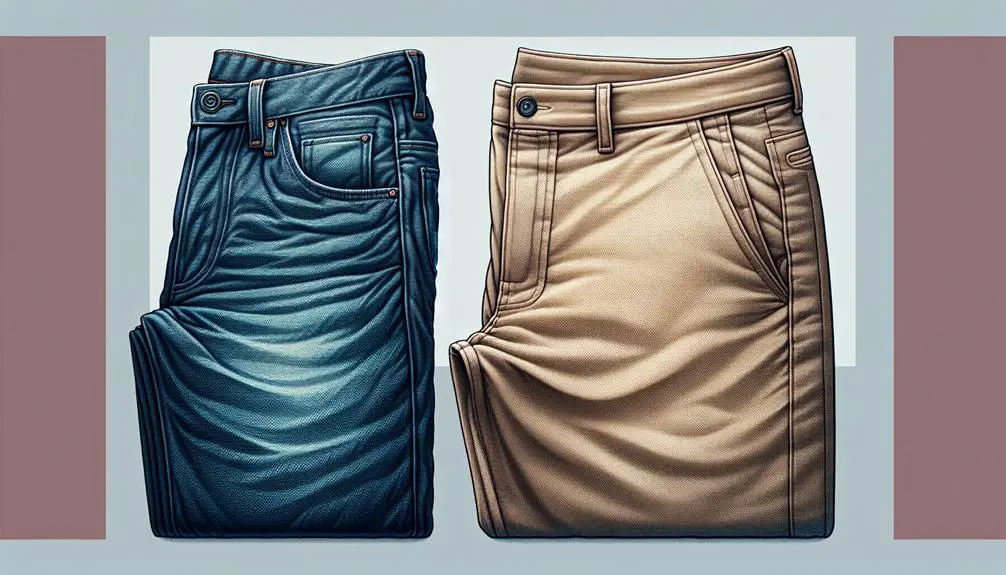I've always been curious about the real deal between denim and non-denim materials. You see, denim's got this rugged, unmistakable vibe, thanks to its cotton twill fabric and that classic indigo dye. But then, there's this whole other world of materials—polyester, rayon, you name it—that offer something different in fashion's vast landscape. They're like chameleons, adapting from casual to formal with ease, and their care varies as much as their appearance. Now, I'm no fabric guru, but I'm keen to explore why choosing between these two could mean more than just picking a pair of jeans over slacks. Let's unwrap this together, shall we?
Table of Contents
Key Takeaways
- Denim is made from 100% cotton in a twill weave, while non-denim can include materials like polyester and spandex.
- Denim is dyed with indigo for a distinctive blue color, whereas non-denim offers a wide range of colors.
- Non-denim fabrics can have various textures, unlike denim's characteristic diagonal ribbing.
- Denim is known for its durability and longevity, which non-denim materials often lack.
- Denim typically requires special care to maintain its color and quality, while non-denim may need different care methods.
Defining Denim and Non-Denim
Let's dive into what exactly sets denim apart from non-denim fabrics, shall we? First off, denim is this really tough cotton twill fabric that's basically the superhero of your wardrobe. It's what your jeans, jackets, and those cool skirts are made from. What makes it special? It's dyed with indigo, giving it that classic blue color that fades in such a cool way over time with wear.
Now, when we're talking non-denim, we're entering a whole different ballpark. Think polyester, rayon, and spandex. These guys offer a rainbow of colors and textures that denim just doesn't. But here's the kicker: they often need a bit more TLC in the care department. I'm talking dry cleaning for some, which can be a bit of a hassle compared to denim's more straightforward care instructions.
Denim's like your laid-back friend who's up for anything, giving off those casual, rugged vibes. Non-denim? It's your versatile pal, ready to dress up for a formal event or dress down for a casual meetup. So, whether you're reaching for that durable denim or a non-denim fabric, you're choosing more than just a material; you're picking a style, a care routine, and, let's be honest, a lifestyle.
Material Composition
Diving into the heart of what sets these fabrics apart, denim's made from 100% cotton in a tough twill weave, while non-denim plays around with a mix like polyester, rayon, or spandex. This basic difference in fabric composition is what gives each its unique charm and functionality. Cotton, especially in that sturdy twill weave, gives denim its renowned durability. The warp thread, often dyed blue, paired with white cotton, crafts denim's iconic look.
On the flip side, non-denim's material blends introduce a world of variety. We're talking different colors, textures, and performance characteristics that denim just can't offer. Polyester can add strength and reduce shrinking, rayon brings a soft touch and a nice drape, and spandex throws in that much-loved stretch.
Each fabric's composition not only dictates its feel and appearance but also its care instructions. Non-denim materials might need a bit more TLC in the laundry department, given their potential to shrink or require special cleaning methods. So, whether you're reaching for that classic denim jacket or a stretchy non-denim pair of pants, it's the fabric composition that's really setting the vibe.
Durability and Longevity
When we talk about what lasts longer in the wardrobe, denim takes the lead over non-denim fabrics, thanks to its tough cotton twill weave. Denim's got this unmatched durability that's pretty hard to find in other materials. You know, it's the kind of stuff that seems to handle whatever life throws at it – spills, stains, you name it. And it's not just about being tough; it's about how this fabric composition holds up over time. We're talking years of wear without giving out.
Now, let's chat about the non-denim side of things. While you might find some decently sturdy fabrics out there, they're often no match for denim's resilience. Materials like polyester or rayon can be great for a season or two, but they often start showing wear and tear way sooner than denim does.
It boils down to this: if you're after longevity and ruggedness in your clothes, denim's your go-to. Its strength is in its very weave, that iconic cotton twill that just refuses to quit. So, when you're weighing up what to add to your wardrobe next, remember, denim's not just a style choice – it's a smart one for lasting wear.
Versatility in Fashion
When it comes to spicing up my closet, I've noticed that non-denim fabrics really open up the possibilities. They're not just for formal events; I can mix and match them for any occasion, making my style game more adaptable.
On the flip side, while I love my denim for its classic vibe, it doesn't offer the same level of flexibility.
Wardrobe Flexibility
Exploring the difference between denim and non-denim, I've realized non-denim fabrics amp up wardrobe flexibility, easily transitioning from formal to casual looks. While denim nails the casual, rugged vibe, perfect for workwear due to its durability, non-denim steps in with its versatile charm.
It's not just about jeans, jackets, or skirts; non-denim fabrics spread their wings across various clothing items and accessories, making them suitable for any occasion. The diversity and colorful palette of non-denim fabrics add a vibrant touch to my wardrobe, breaking the monotony with pastels and bright shades.
This versatility means I can tailor my outfit to match the formality of an event or the relaxed atmosphere of a casual meetup, significantly expanding my fashion choices.
Style Adaptation
Building on the idea of wardrobe flexibility, let's examine how style adaptation showcases the real versatility in fashion.
Here's the thing: denim's your go-to for that casual and rugged look, right? But step into the world of non-denim, and you're playing on a whole new level. You've got options for both formal and casual wear, rocking a broader range of colors and textures.
While denim's durability in workwear is unmatched, non-denim brings its A-game with fashion trends, offering different cuts and styles for every season. Sure, denim has that timeless appeal, but remember, those non-denim pieces might need a bit more TLC with specific care instructions.
Care and Maintenance
Properly taking care of your denim and non-denim fabrics can really make a difference in how long they last and look. I've learned that denim needs a bit of special attention, like washing it inside out to keep the color and quality top-notch. It's not just a random tip; it's crucial for maintaining that crisp, just-bought look. And, oh, you've got to follow those washing guidelines to a T to avoid any unwanted shrinkage.
But when it comes to non-denim fabrics, the care instructions can be all over the place, depending on what you're dealing with. Some of these fabrics might even need to hit the dry cleaners to stay in shape, which is a whole different game than tossing them in the wash.
Regularly washing your denim does have its perks, though. It softens up the fabric, making those jeans your go-to comfort wear. But it's a fine balance between keeping them clean and preserving that color quality. Whether it's denim or non-denim, mastering the maintenance of your fabrics means you're not just wearing clothes; you're caring for them, ensuring they're always ready to make you look your best.
Environmental Impact
It's shocking how much water and chemicals go into making our jeans, seriously affecting the planet. We're talking about a huge environmental impact here. Denim production isn't just thirsty work; it's also full of chemical treatments that can lead to water pollution and soil contamination.
But it's not just denim that's the problem. Non-denim fabrics, especially those made from polyester, are contributing to microfiber pollution in our oceans. These tiny fibers are washing out of our clothes and into the water supply, where they're causing a whole heap of issues.
And here's the kicker: those non-biodegradable synthetic fibers in non-denim items stick around for ages, posing a long-term threat to our environment. But there's a silver lining. Sustainable practices are making headway in the fashion industry. We're seeing a shift towards using organic cotton and eco-friendly dyeing methods that lessen the blow to our planet.
It's a step in the right direction, reducing water usage and ditching those harsh chemicals. By leaning into these sustainable practices, we're paving the way for a more eco-conscious approach to both denim and non-denim production.
Frequently Asked Questions
What Is the Difference Between Denim and Regular Jeans?
I've realized there's no difference between denim and regular jeans because denim is the fabric jeans are made from. It's all about the material, not separate categories of clothing. Jeans are just denim pants.
What Makes Denim Different?
I've learned that denim's unique because it's made from 100% cotton twill, dyed with indigo for that classic blue. It's super durable, ideal for casual wear, and has a distinct rugged look.
What Is the Difference Between Real Denim and Fake Denim?
I've learned that real denim's made of 100% cotton, lasts longer, and fades uniquely, while fake denim, often synthetic, lacks durability and doesn't age well. It's about quality and the authentic denim experience.
Why Is It Called Jeans Not Denim?
It's called jeans, not denim, because "jeans" refers to the style of pants, while "denim" is the fabric they're made from. The term became popular due to its durable nature for workwear.
- The Use of Nonwovens in Construction and Civil Engineering - July 11, 2025
- The Use of Nonwovens in Construction and Civil Engineering - July 11, 2025
- The Use of Nonwovens in Construction and Civil Engineering - July 11, 2025






